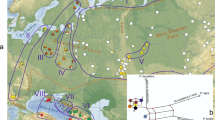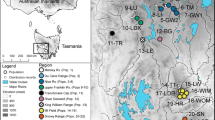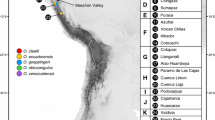Abstract
The contemporary genetic structure of species offers key imprints of how organisms responded to past geological and climatic events, which have played a crucial role in shaping the current geographical distribution of north-temperate organisms. In this study, range-wide patterns of genetic variation were examined in Douglas-fir (Pseudotsuga menziesii), a dominant forest tree species distributed from Mexico to British Columbia in western North America. Two organelle DNA markers with contrasting modes of inheritance were genotyped for 613 individuals from 44 populations. Two mitotypes and 42 chlorotypes were recovered in this survey. Both genomes showed significant population subdivision, indicative of limited gene flow through seeds and pollen. Three distinct cpDNA lineages corresponding to the Pacific Coast, the Rocky Mountains, and Mexico were observed. The split time of the two lineages from the Rockies lineage was dated back to 8.5 million years (Ma). The most recent common ancestors of Mexican and coastal populations were estimated at 3.2 and 4.8 Ma, respectively. The northern populations of once glaciated regions were characterized by a high level of genetic diversity, indicating a large zone of contact between ancestral lineages. A possible northern refugium was also inferred. The Mexican lineage, which appeared established by southward migration from the Rockies lineage, was characterized by the lowest genetic diversity but highest population differentiation. These results suggest that the effects of Quaternary climatic oscillations on the population dynamics and genetic diversity of Douglas-fir varied substantially across the latitudinal section. The results emphasize the pressing need for the conservation of Mexican Douglas-fir.



Similar content being viewed by others
References
Anderson LL, Nelson DM, Petit RJ, Paige KN (2006) Ice-age endurance: DNA evidence of a white spruce refugium in Alaska. Proc Natl Acad Sci USA 103:12447–12450
Bandelt H-J, Forster P, Arne R (1999) Median-joining networks for inferring intraspecific phylogenies. Mol Biol Evol 16:37–48
Bouillé M, Bousquet J (2005) Trans-species shared polymorphisms at orthologous nuclear gene loci among distant species in the conifer Picea (Pinaceae): implications for the maintenance of genetic diversity in trees. Am J Bot 92:63–73
Bouillé M, Senneville S, Bousquet J (2011) Discordant mtDNA and cpDNA spruce phylogenies indicate geographic speciation and reticulation as driving factors for the diversification of the genus Picea. Tree Genet Genomes. doi:10.1007/s11295-010-0349-z
Brunsfeld SJ, Miller TR, Carstens BC (2007) Insights into the biogeography of the Pacific Northwest of North America: evidence from the phylogeography of Salix melanopsis. Syst Bot 32:129–139
Comes HP, Kadereit JW (1998) The effect of quaternary climatic changes on plant distribution and evolution. Trends Plant Sci 3:432–438
Critchfield WB (1984) Impact of the Pleistocene on the genetic structure of North America conifers. In: Proceedings of 8th North American Forest Biology Workshop, Logan, UT
Debreczy Z, Racz I (1995) New species and varieties of conifers from Mexico. Phytologia 78:217–243
Drummond J, Rambaut A (2007) BEAST: Bayesian evolutionary analysis by sampling trees. BMC Evol Biol 7:214
Eckert AJ, Bower AD, Wegrzyn JL, Pande B, Jermstad KD, Krutovsky KV, St. Clair JB, Neale DB (2009a) Association genetics of coastal Douglas-fir (Pseudotsuga menziesii var. menziesii, Pinaceae). I. Cold–hardiness related traits. Genetics 182:1289–1302
Eckert AJ, Wegrzyn JL, Pande B, Jermstad KD, Lee JM, Liechty JD, Tearse BR, Krutovsky KV, Neale DB (2009b) Multilocus patterns of nucleotide diversity and divergence reveal positive selection at candidate genes related to cold hardiness in coastal Douglas fir (Pseudotsuga menziesii var. menziesii). Genetics 183:289–298
Excoffier L, Laval G, Schneider S (2005) Arlequin version 3.0: an integrated software package for population genetics data analysis. Evol Bioinf Online 1:47–50
Farjon A (1990) Pinaceae. Koeltz Scientific Books, Koenigstein, Germany
Flous F (1934) Deux espèces nouvelles de Pseudotsuga Américains. Bull Soc Hist Nat Toulouse 66:211–224
Gérardi J, Jaramillo-Correa JP, Beaulieu J, Bousquet J (2010) From glacial refugia to modern populations: new assemblages of organelle genomes generated by differential cytoplasmic gene flow in transcontinental black spruce. Mol Ecol 19:5265–5280
Godbout J, Jaramillo-Correa JP, Beaulieu J, Bousquet J (2005) A mitochondrial DNA minisatellite reveals the postglacial history of jack pine (Pinus banksiana), a broad-range North American conifer. Mol Ecol 14:3497–3512
Godbout J, Fazekas A, Newton CH, Yeh FC, Bousquet J (2008) Glacial vicariance in the Pacific Northwest: evidence from a lodgepole pine mitochondrial DNA minisatellite for multiple genetically distinct and widely separated refugia. Mol Ecol 17:2463–2475
Godbout J, Beaulieu J, Bousquet J (2010) The phylogeographic structure of jack pine (Pinus banksiana; Pinaceae) supports the existence of a coastal glacial refugium in northeastern North America. Am J Bot 97:1903–1912
Graham A (1993) Flora of North America. In: History of the vegetation, Cretaceous–Tertiary. Oxford University Press, New York, Vol. 1, pp 57–70
Graham A (1995) Development of affinities between Mexican/Central American and northern South American lowland and lower montane vegetation during the Tertiary. In: Churchill SP, Forero HE, Luteyn J (eds) Biodiversity and conservation of neotropical montane forests. New York Botanical Garden, New York, pp 11–22
Graham A (1999a) The Tertiary history of the northern temperate element in the northern Latin American biota. Am J Bot 86:32–38
Graham A (1999b) Late Cretaceous and Cenozoic history of North American vegetation. Oxford University Press, New York
Gugger PF, Sugita S, Cavender-Bares J (2010a) Phylogeography of Douglas-fir based on mitochondrial and chloroplast DNA sequences: testing hypotheses from the fossil record. Mol Ecol 19:1877–1897
Gugger PF, Gonzalez-Rodriguez A, Rodriguez-Correa H, Sugita S, Cavender-Bares J (2010b) Southward Pleistocene migration of Douglas-fir into Mexico: phylogeography, ecological niche modelling, and conservation of ‘rear edge’ populations. New Phytol 189:1185–1199
Hermann RK, Lavender DP (1999) Douglas-fir planted forests. New For 17:53–70
Hewitt GM (1996) Some genetic consequences of ice ages, and their role in divergence and speciation. Biol J Linn Soc 58:247–276
Hewitt GM (1999) Post-glacial recolonization of European biota. Biol J Linn Soc 68:87–112
Hewitt GM (2000) The genetic legacy of the Quaternary ice ages. Nature 405:907–913
Holliday JA, Ritland K, Aitken SN (2010) Widespread, ecologically relevant genetic markers developed from association mapping of climate-related traits in Sitka spruce (Picea sitchensis). New Phytol 188:501–514
Ibrahim KM, Nichols RA, Hewitt GM (1996) Spatial patterns of genetic variations generated by different forms of dispersal during range expansion. Heredity 77:282–291
Jaramillo-Correa JP, Bousquet J (2005) Mitochondrial genome recombination in the zone of contact between two hybridizing conifers. Genetics 171:1951–1962
Jaramillo-Correa JP, Beaulieu J, Bousquet J (2004) Variation in mitochondrial DNA reveals multiple distant glacial refugia in black spruce (Picea mariana), a transcontinental North American conifer. Mol Ecol 13:2735–2747
Jaramillo-Correa JP, Beaulieu J, Ledig FT, Bousquet J (2006) Decoupled mitochondrial and chloroplast DNA population structure reveals Holocene collapse and population isolation in a threatened Mexican-endemic conifer. Mol Ecol 15:2787–2800
Jaramillo-Correa JP, Beaulieu J, Khasa DP, Bousquet J (2009) Inferring the past from the present phylogeographic structure of North American forest trees: seeing the forest for the genes. Can J For Res 39:286–307
Klicka J, Zink RM (1997) The importance of recent ice ages in speciation: a failed paradigm. Science 277:1666–1669
Lakhanpal RN (1958) The Rujada flora of west central Oregon. Univ Calif Publ Geol Sci 35:1–66
Ledig FT, Jacob-Cervantes V, Hodgskiss PD, Eguiluz-Piedra T (1997) Recent evolution and divergence among populations of a rare Mexican endemic, Chihuahua spruce, following Holocene climatic warming. Evolution 51:1815–1827
Lemmon EM, Lemmon AR, Cannatella DC (2007) Geological and climatic forces driving speciation in the continentally distributed trilling chorus frogs (Pseudacris). Evolution 61:2086–2103
Li P, Adams WT (1989) Range-wide patterns of allozyme variation in Douglas-fir (Pseudotsuga menziesii). Can J For Res 19:149–161
Librado P, Rozas J (2009) DnaSP v5: a software for comprehensive analysis of DNA polymorphism data. Bioinformatics 25:1451–1452
Mapula-Larreta M, Lopez-Upton J, Vargas-Hernandez JJ, Hernandez-Livera A (2007) Reproductive indicators in natural populations of Douglas-fir in Mexico. Biodivers Conserv 16:727–742
Marshall HD, Newton C, Ritland K (2001) Sequence-repeat polymorphisms exhibit the signature of recombination in lodgepole pine chloroplast DNA. Mol Biol Evol 18:2136–2138
Martinez M (1963) Las Pinaceae Mexicanas, 3rd edn. Universidad Nacional Autonoma de Mexico, Mexico
Mogensen HL (1996) The hows and ways of cytoplasmic inheritance in seed plants. Am J Bot 83:383–404
Namroud M-C, Beaulieu J, Juge N, Laroche J, Bousquet J (2008) Scanning the genome for gene single nucleotide polymorphisms involved in adaptive population differentiation in white spruce. Mol Ecol 17:3599–3613
Naydenov K, Senneville S, Beaulieu J, Tremblay FM, Bousquet J (2007) Glacial vicariance in Eurasia: mitochondrial DNA evidence from Scots pine for a complex heritage involving genetically distinct refugia at mid-northern latitudes and in Asia Minor. BMC Evol Biol 7:233, 12p
Opgenoorth L, Vendramin GG, Mao K, Miehe G, Miehe S, Liepelt S, Liu J, Ziegenhagen B (2010) Tree abundance on the Tibetan Plateau marks the world’s highest known tree line of the Last Glacial Maximum. New Phytol 185:332–342
Perron M, Perry DJ, Andalo C, Bousquet J (2000) Evidence from sequence-tagged-site markers of a recent progenitor-derivative species pair in conifers. Proc Natl Acad Sci USA 97:11331–11336
Petit RJ, Kremer A, Wanger DB (1993) Finite island model for organelle and nuclear genes in plants. Heredity 71:630–641
Petit RJ, Aguinagalde I, de Beaulieu JL et al (2003) Glacial refugia: hotspots but not melting pots of genetic diversity. Science 300:1563–1565
Petit RJ, Duminil J, Fineschi S, Hampe A, Salvini D, Vendramin GG (2005) Comparative organization of chloroplast, mitochondrial and nuclear diversity in plant populations. Mol Ecol 14:689–701
Petit RJ, Hu FS, Dick CW (2008) Forests of the past: a window to future changes. Science 320:1450–1452
Pons O, Petit RJ (1996) Measuring and testing genetic differentiation with ordered versus unordered alleles. Genetics 144:1237–1245
Posada D, Crandall KA (1998) Modeltest: testing the model of DNA substitution. Bioinformatics 14:917–918
Provan J, Bennett KD (2008) Phylogeographic insights into cryptic glacial refugia. Trends Ecol Evol 23:564–571
Prunier J, Laroche J, Beaulieu J, Bousquet J (2011) Scanning the genome for gene SNPs related to climate adaptation and estimating selection at the molecular level in boreal black spruce. Mol Ecol. doi:10.1111/j.1365-294X.2011.05045.x
Ronquist F, Huelsenbeck JP (2003) MrBayes 3: Bayesian phylogenetic inference under mixed models. Bioinformatics 19:1572–1574
Rowe KC, Heske EJ, Brown PW, Paige KN (2004) Surviving the ice: Northern refugia and postglacial colonization. Proc Natl Acad Sci USA 101:10355–10359
Schorn HE (1994) A preliminary discussion of fossil larches (Larix, Pinaceae) from the Arctic. Quatern Int 22(23):173–183
Shaw J, Lickey EB, Beck JT, Farmer SB, Liu W, Miller J, Siripun KC, Windel CT, Schilling EE, Small RL (2005) The tortoise and the hare II: relative utility of 21 noncoding chloroplast DNA sequences for phylogenetic analysis. Am J Bot 92:142–166
Soltis DE, Gitzendammer MA, Strenge DD, Soltis PS (1997) Chloroplast DNA intraspecific phylogeography of plants from the northwest of North America. Plant Syst Evol 206:353–373
Strong WL (2010) Pinus contorta var. yukonensis var. nov. (Pinaceae) from south-central Yukon, Canada. Nord J Bot 28:448–452
Taberlet P, Fumagalli L, Wust-Saucy AG, Cosson JF (1998) Comparative phylogeography and postglacial colonization routes in Europe. Mol Ecol 7:453–464
Thompson JD, Gibson TJ, Plewniak F, Jeanmougin F, Higgins DG (1997) CLUSTAL-X windows interface: flexible strategies for multiple sequence alignment aided by quality analysis tools. Nucleic Acids Res 25:4876–4882
Walter R, Epperson BK (2005) Geographic pattern of genetic diversity in Pinus resinosa: contact zone between descendants of glacial refugia. Am J Bot 92:92–100
Wei XX, Yang ZY, Li Y, Wang XQ (2010) Molecular phylogeny and biogeography of Pseudotsuga (Pinaceae): insights into the floristic relationship between Taiwan and its adjacent areas. Mol Phylogenet Evol 55:776–785
Wheeler NC, Jermstad KD, Krutovsky KV, Aitken SN, Howe GT, Krakowski J, Neale DB (2005) Mapping of quantitative trait loci controlling adaptive traits in coastal Douglas-fir. IV. Cold–hardiness QTL verification and candidate gene mapping. Mol Breed 15:145–156
Wright JW, Kung FH, Read RA, Lemmien WA, Bright JN (1971) Genetic variation in Rocky Mountain Douglas-fir. Silvae Genet 20:54–60
Zachos J, Pagani M, Sloan L, Thoma E, Billups K (2001) Trends, rhythms and aberrations in global climate 65 Ma to present. Science 292:686–693
Acknowledgments
We thank S. Senneville and S. Blais (Canada Research Chair in Forest and Environmental Genomics, Univ. Laval), as well as M. Deslauriers and P. Laplante (Natural Resources Canada, Canadian Forest Service) for laboratory assistance. We are grateful to S. Gérardi, J. Godbout, and M. Lemieux (Canada Research Chair in Forest and Environmental Genomics) for their help with data analysis and for valuable discussions. We also thank the two anonymous reviewers and the associate editor S. Aitken for their insightful comments and suggestions on this manuscript. Our thanks are also due to G.E. Rehfeldt (USDA Forest Service in Moscow, Idaho) and F.T. Ledig (UC Davis, California) for providing seeds of the three Douglas-fir populations of the Rockies-transition region, and of P. macrocarpa, respectively. The collections of samples for Mexican populations and for P. sinensis were supported by CONACYT (Grant 33617-B and 2002-C01-6416) and the National Natural Science Foundation of China (Grant No. 30500030), respectively. This study was supported by grants from the Mexico-Québec Program of the Ministère du Développement économique, de l’innovation et de l’exportation du Québec, the National Sciences and Engineering Research Council of Canada, and Natural Resources Canada. This study was part of a task of the Forest Genetic Resources Working Group of the North American Forest Commission/Food and Agricultural Organization of the United Nations.
Author information
Authors and Affiliations
Corresponding author
Additional information
Communicated by S. Aitken
Electronic supplementary material
Below is the link to the electronic supplementary material.
Supplementary Table S1
Non-hierarchical AMOVAs for each of the six regions of Douglas-fir based on chlorotype frequencies for the cpDNA trnfM-trnS intergenic spacer (PDF 78 kb)
Rights and permissions
About this article
Cite this article
Wei, XX., Beaulieu, J., Khasa, D.P. et al. Range-wide chloroplast and mitochondrial DNA imprints reveal multiple lineages and complex biogeographic history for Douglas-fir. Tree Genetics & Genomes 7, 1025–1040 (2011). https://doi.org/10.1007/s11295-011-0392-4
Received:
Revised:
Accepted:
Published:
Issue Date:
DOI: https://doi.org/10.1007/s11295-011-0392-4




